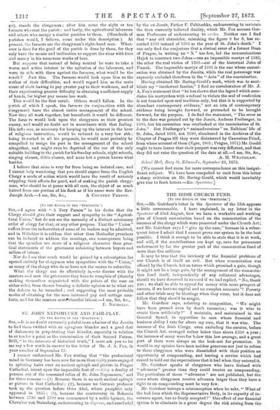ST. JOHN NEPOMUCEN AND FAIR-PLAY.
[TO THE EDITOR. OF THE "SPECTATOR."] SIR,-It is no doubt extremely painful to an admirer of the Jesuits to find them twitted with an egregious blunder and a good deal of dishonesty in perpetrating that blunder, especially in relation to so tender a point as the canonisation of their Second Patron. Still, " iu the interests of historical truth," I must ask you to let me say a few words in answer to the letter of Mr. J. A. Fox, in your number of September 13.
I cannot understand Mr. Fox stating that "the professional mind in Germany has been now for more than eighty years engaged in splitting hairs over au ancient epitaph and picture in Prague Cathedral, intent upon the impossible feat of evolving a duality of persons out of the venerated relics of St. John Nepomucen," and for three reasons :—(1) Because there is no such ancient epitaph or picture in that Cathedral ; (2), because no German professor took up the question before Otto Abel, whose pamphlet only appeared in 1835 ; (3), because the controversy in Bohemia between 1783 and 1790 was commenced by a noble layman, the Chevalier von Steinsberg, endeavouring to disprove, and concluded by the ex-Jesuit, Father F. Pubitschka, endeavouring to maintaiir the then currently believed duality,• which Mr. Fox accuses Ger- man Professors of endeavouring to evolve. Neither can I find that " any old, chronicler, mistaking the figure 9 for 8, has re- corded 1383 instead of 1393 as the year of St. John's death." I can only find the conjecture that a clerical error of a former Dean of Prague, in writing an " X " too few, led the nnconscientious Hajek to construct two Johns—one an impossible martyr of 1383; the other the real victim of 1393—out of the historical John of Pomuk. The impossible martyr of 1383 is the one whose canoni- sation was obtained by the Jesuits, while the real personage was expressly excluded therefrom in the " Acta" of the canonisation.
Having obtained Mr. Baring-Gould's work, which was to anni- hilate my "incoherent fancies," I find no corroboration of Mr. J. A. Fox's statement that " he has shown that the legend which asso- ciates his martyrdom with a refusal to violate the seal of confession is not founded upon oral tradition only, but that it is supported by abundant contemporary evidence," not an iota of contemporary evidence being brought forward, or pretended to be brought forward, for the purpose. I do find the statement, " The error as to the date was pointed out by the Jesuit, Andreas Freiberger, im 1680, but his correction was overlooked at the canonisation of St. John." But Freiberger's " animadversions " on Balbinus' life of St. John, dated 1698, not 1680, slumbered in the Archives of the Chapter of Prague till they were disinterred by Canonicus Frind, from whose account of them (Eger, 1861; Prague, 1871) Mr. Gould. ought to have learnt that their purport was very different, and that they did not raise the question of the date at all.—I am, Sir, &c.,.
A. II. WRATISLAW.
School Hall, Bury St. Edmunds, September 23, 1873.
[We cannot find room for more correspondence on this insigni- ficant subject. We have been compelled to omit from this letter a sharp criticism on Mr. Baring-Gould, which would inevitably give rise to fresh letters.—En. Spectator.]


































 Previous page
Previous page